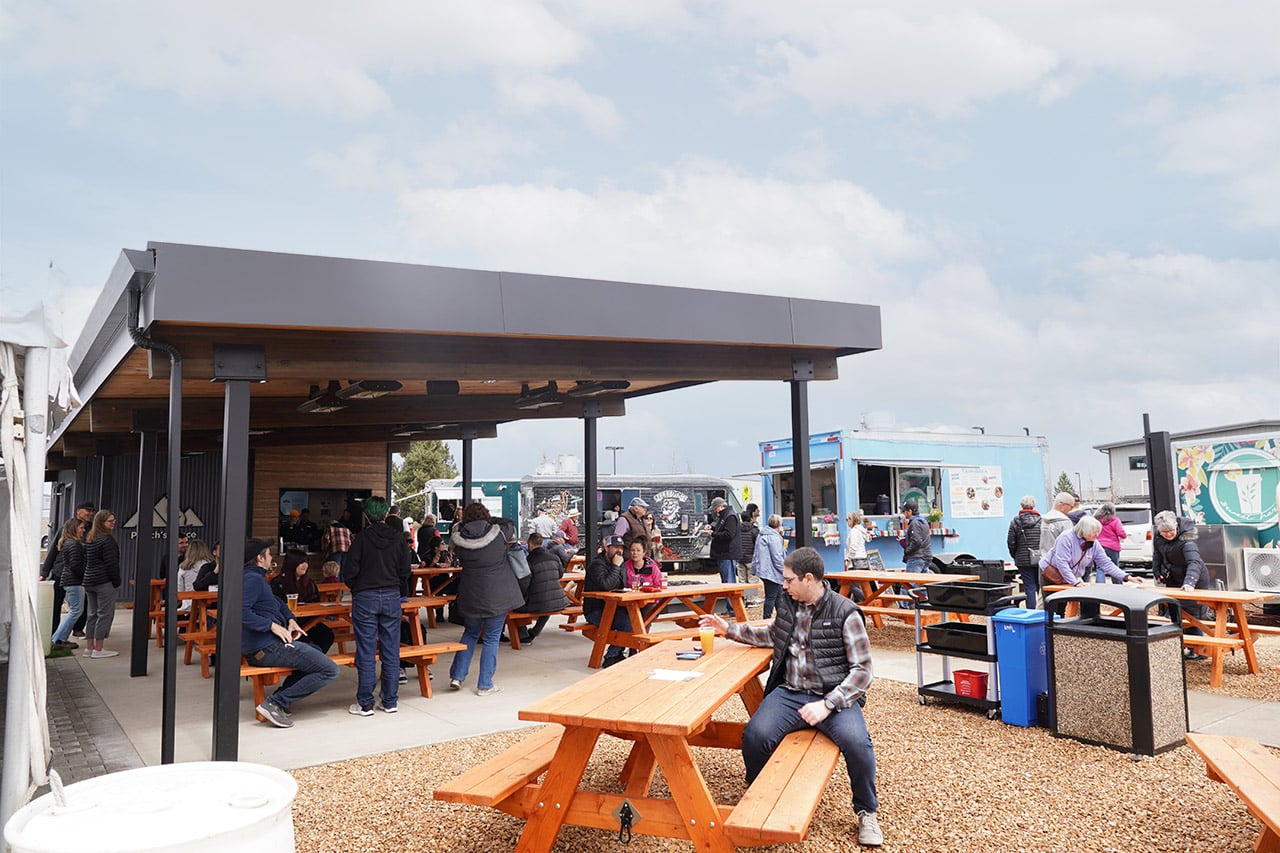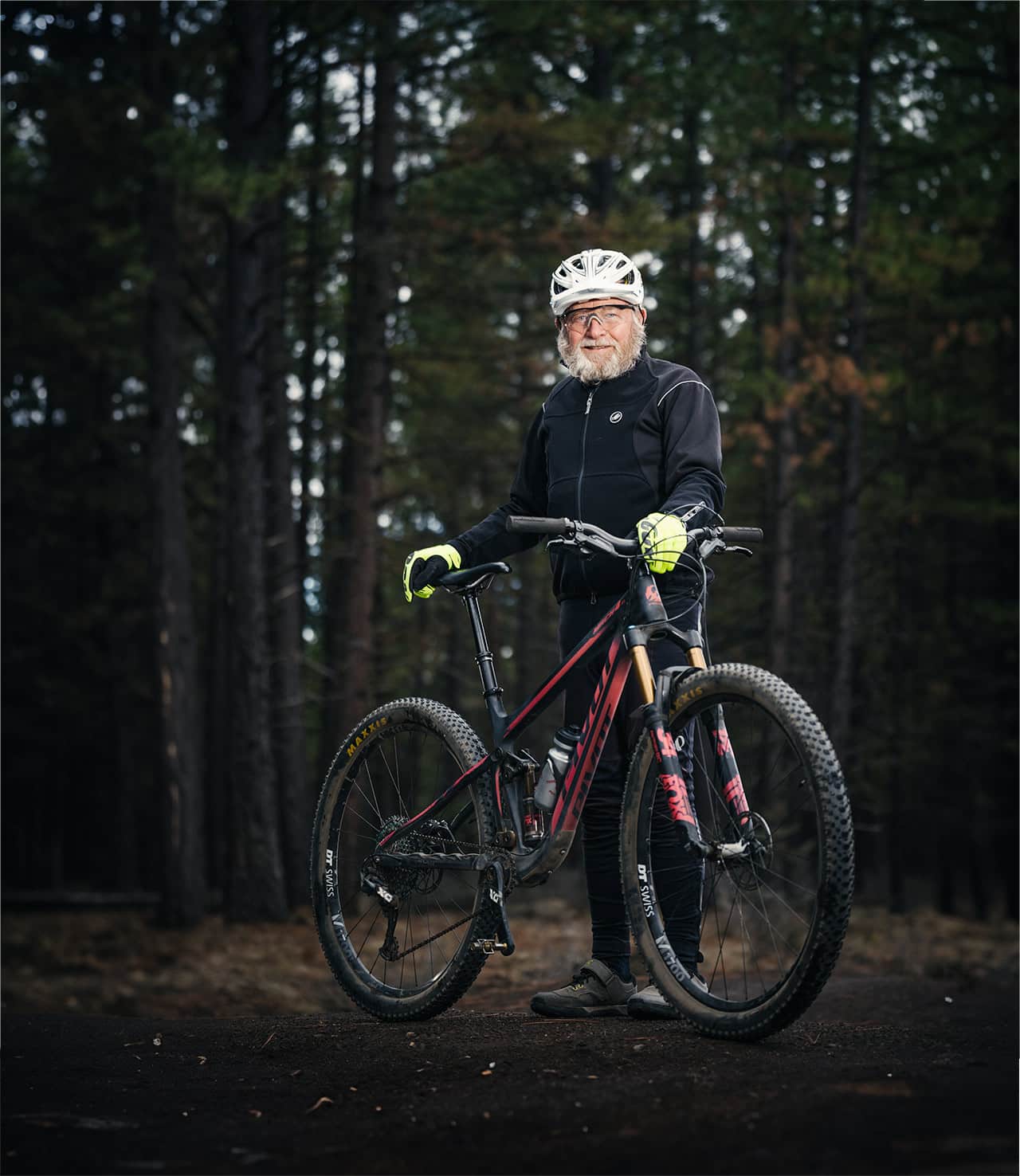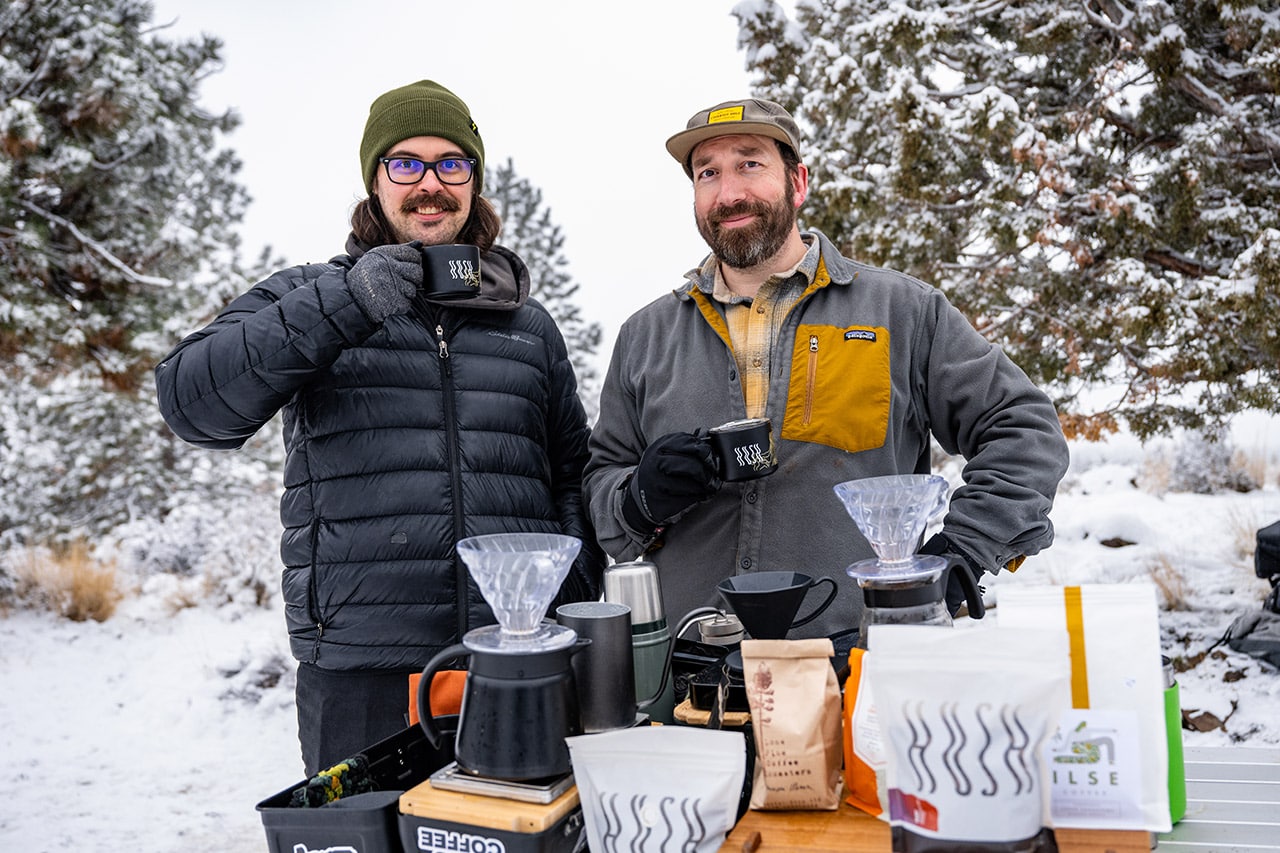A pioneering forest restoration management program has melded leading edge science and community consensus to protect a volatile and highly visible swath of Central Oregon’s public lands from the mounting threats of climate change and a catastrophic Central Oregon wildfire.
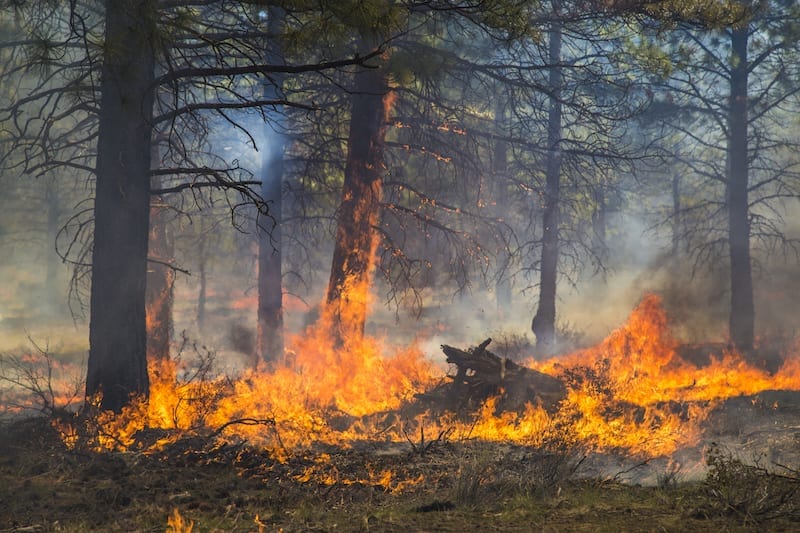
Like many Central Oregonians, Pete Caligiuri has a personal connection to the forest. Caligiuri was raised in Redmond and grew familiar with the lakes, trails, and quiet spaces that beckon thousands of visitors and newcomers here every year. He left to pursue an education and a career on the East Coast. Yet it was restoration—not recreation—that Caligiuri had on his mind when he came back to Central Oregon to work on a pioneering forest initiative for the Nature Conservancy.
Over the past several years, Caligiuri, a Yale-educated forest ecologist, sat alongside loggers, environmentalists, scientists and recreation advocates as part of the Deschutes Collaborative Forest Project—one of the first of its kind in the country. The goal was to hammer out a management strategy for a roughly 257,000-acre swath of forest just west of Bend, stretching from Sunriver to Sisters. It’s a contiguous sea of emerald pine spires painted against a dramatic mountain backdrop of snowcapped Cascade wilderness peaks that serves as a playground for locals and visitors alike. The pine forest, a mix of majestic red-barked ponderosa and lodgepole pine and fir trees, is deeply connected to the region’s economic past and its future. It was once home to one of the most extensive and intensive logging operations on the West Coast, a rough and tumble business that fueled Bend’s sawmill economy for nearly a century. Today the big trees are mostly gone, as are the mills.
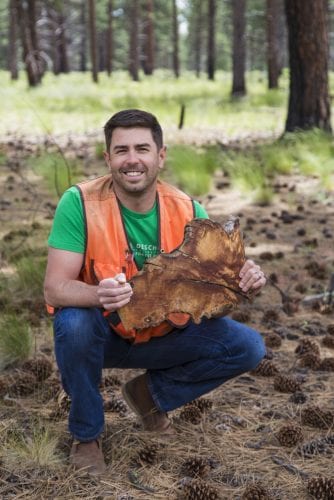
The forest is largely quiet, a haven for wildlife and hub of recreation that drives a $500 million local tourism economy, based on exploring rather than exploiting the forest. But that’s the glass-half-full version. Come July and August, the forest west of Bend is also a tinderbox of dense trees and brushes that, some say, is a ticking time bomb of sorts. The huge stockpile of fuels in an overly dense forest is ripe for a wildfire. The impact of such an event would be catastrophic: Valuable wildlife habitat destroyed, hundreds of miles of popular hiking and biking trails obliterated, scores of homes that have been built on the ever-expanding fringes of Bend and Sisters at risk.
“All the climate indications suggest that we are going to have longer summers, uncertain precipitation, [and] potentially longer, hotter fire seasons. So, if anything, fire is going to become a more dominant force once again, one that we are not able to control,” said Caligiuri.
Recognizing that the stakes were high from an ecological and economic perspective, Caligiuri and the rest of the steering committee developed a set of recommendations that have been largely implemented by the Forest Service. A central element of that plan is a strategy of more, not less, fire in the forest. The approach did more than just reduce fuels, it has helped land managers restore entire sections of forest to conditions that existed before a century of grazing, logging and fire suppression altered the landscape. It began with a desire to better understand the role that humans and industrial activity have played on the evolution of the forest. By understanding human impacts, the Deschutes Collaborative Forest Project, or DCFP, could begin to mitigate them.
“The forest restoration problem is a social problem with an ecological explanation,” explained Caligiuri, whose organization has helped drive both the science and the social elements of the collaborative project.
Old Ways, New Problems
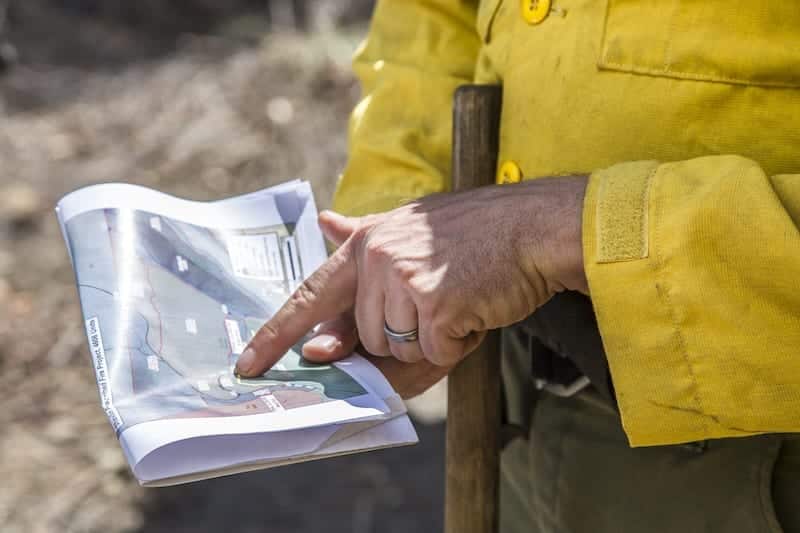
Until recently, there has been little consensus about the best way to address the challenges faced by forests. Environmentalists didn’t want to see an aggressive logging plan. The Forest Service didn’t have the resources to do large-scale thinning and clean-up work to reduce fuels across such a large area. The result was gridlock, a status quo standoff that ensured inaction as the forest deteriorated and the time bomb kept ticking.
“We have this homogenous sea of even-aged trees and they are really dense. Our soil precipitation doesn’t sustain that kind of density well,” said Nicole Strong, a forester and researcher at Oregon State University who worked with the collaborative. “What I see are too many trees and not enough shrubs and grasses and not enough open spaces. It’s not a very resilient system.”
Despite disagreements over how to manage the forest, stakeholders from across the spectrum agree that the forest is integral to the community’s economic health and the region’s quality of life.
“I think what we want is a forest that continues to provide this broad suite of benefits that everyone cares about,” said Caligiuri. “Everything from jobs in the woods to, in our case, an economy that is squarely dependent on a healthy forest for tourism and recreation, [in addition] to things like drinking water and clean air. All of those values depend on healthy, resilient forests.”
That was the starting point seven years ago when members of the fledgling DCFP steering committee got together and started talking about shared interest and compromise. The group, which includes more than a dozen stakeholders, developed a set of recommendations to restore more than a quarter-million acres of forest land stretching from outside Sisters to southwest of Bend. The project, which has been underway since 2010, uses a collaborative process to develop recommendations for forest management.
“What is unique about the Deschutes Collaborative is it’s not being run or administered by the Forest Service. We are really just a partner,” offered John Allen, Deschutes National Forest Supervisor.
It’s an approach that was born out of years of gridlock, frustration and protracted litigation between the Forest Service, environmentalists and the forest industry—groups with very different views about the best use of forest resources. In Bend, the result is a plan that removes hurdles to forest management, but does so based upon shared values and clearly defined outcomes, such as the protection of animal habitat and the removal of dangerous fuels. The DCFP required that participants, many of whom were veterans of the Northwest timber wars, not just listen to alternative viewpoints, but embrace ideas that were once seen as heretical. Environmentalists signed off on logging plans; loggers embraced the idea of leaving behind some of the most valuable trees. In the case of the Forest Service, an agency that spent more than a century obsessively putting out fires, crews were sent into the woods to intentionally light fires in the hopes of preventing one.
A New Approach

The DCFP was one of the first plans to be funded under the federal Collaborative Forest Restoration bill that Congress passed in 2009. Since then the program has grown, from ten to more than twenty collaboratives, mostly around the West, where the timber battles have been the most pitched. There are two more in Eastern Oregon, one on the Freemont-Winema Forest near Lakeville and another in the Blue Mountains on Malheur National Forest land. Another independent, community-based collaborative is underway in Prineville. By most accounts the projects have been a success, helping longtime adversaries sit down in the same room to find common ground, certainly something that some participants didn’t think existed at the outset. They have also created a blueprint of sorts for how to manage at least a slice of our vast inventory of public lands at a time when there is little consensus among interest groups about how to do that. It’s a particularly pressing matter for the Forest Service, which is tasked with managing millions of acres of public land with a shrinking pool of resources.
“I would hope that we can use what we’ve learned and put it to work on the entire Deschutes National Forest,” said Allen. “This could be a model for how we look at community forests. And it’s really a partnership between the community and the National Forest.”
From community and consensus building to funding, the collaborative forest framework has helped to free the agency to do the work that it has long believed was necessary to ensure the health of the forest. The agency is projected to spend about $20 million on the Deschutes Collaborative Forest, half of which is coming directly from Washington, D.C. through the Collaborative Forest Project Act, money that otherwise would not have been available. Those dollars subsidize the expensive and time-consuming work of small-diameter tree removal and brush thinning that commercial loggers typically avoid. Whether that work would have happened without the collaborative is the subject of some debate, but it certainly wouldn’t have occurred with the speed or community support that it currently has, according to Allen.
Several years into implementation, the tree removal and thinning work has been highly visible and not without controversy. So far, the Forest Service and partners have harvested roughly thirty million board feet of timber just west of Bend, some of it along the area’s popular trails. Around the iconic Phil’s Trail complex, several popular trails have been shut down for extended periods while logging and thinning crews removed trees. Then, when users returned to the trails, they were greeted by a landscape that was almost unrecognizable in places. For trail users who were deeply familiar with, and attached to, the status quo, it was a visually jarring experience.
“I would say shock is the most common reaction,” said Melanie Fisher, a member of the DCFP steering committee and former co-owner of Cog Wild bike tour company in Bend.
Fisher has spent years riding and guiding in the forest, but she became convinced that the forest near and dear to her heart, as well as her bottom-line, was unhealthy in a way that presented a risk to itself and to users. Fisher looked around the forest and saw a landscape of dense and immature trees. She wondered what would happen if a wildfire were to erupt. How would bikers and hikers be alerted to the danger? Would they have time to escape a fast-moving blaze? What if she were out with friends or clients? It was clear to her that Bend needed a more fire-tolerant forest, one that could withstand what many saw as inevitable: a wildfire near Bend moving too quickly and burning too hot for fire crews to beat back.
Playing with Fire

One needn’t look far for examples of the forest’s volatility around Central Oregon. In just the past five years, two major wildfires have erupted on private and public lands between Bend and Sisters. The Pole Creek fire burned forty-one square miles west of Sisters in 2012, threatening homes and completely consuming vast acres of forest that included hiking trails and wildlife habitat. Cars that were parked at the Pole Creek trailhead near Sisters burned like campfire logs, along with the lodgepole and pine trees. No one was hurt in the fire, but it proved a dramatic example of the speed and ferocity at which a modern forest fire grows. Only two years later, the Two Bulls Fire erupted in July of 2014, burning almost eleven square acres in dramatic fashion, filling the western horizon with dancing flames and thick plumes of smoke visible from afar. The fire forced the evacuation of 250 homes on the west side of Bend. The homes ultimately were spared after winds and weather shifted, allowing firefighters to gain control of the blaze. For longtime Bendites, the fire evoked memories of another blaze that blew up quickly and made a bee-line toward Bend: the Awbrey Hall fire of 1991. That fast-moving blaze ultimately consumed twenty-two homes on Bend’s Westside, including Ann Malkin’s home in Mount Bachelor Village.
The flames came without warning, Malkin recalled. It was hot and dry, but an otherwise postcard-perfect July day spent exploring the Cascade Lakes with her family and some out-of-town friends. The first sign of trouble didn’t come until the afternoon when she and her then-husband, Dave, rounded a corner near Mt. Bachelor and spotted a tall pillar of white smoke on the horizon. Malkin remembers thinking that it seemed awfully close to Bend—but she still didn’t know how close. By the time she and her family arrived home, firefighters were already in their west Bend neighborhood coordinating an evacuation. She had just a few minutes to grab photo albums, fleeing with celluloid memories and her then four-year-old daughter in tow. Within a few hours the home was burned to the ground. Even the metal window frames melted in the blaze. There was nothing to salvage. One of the sole recognizable items was a dime store Christmas tree stand. There was no rhyme or reason as to the fire’s path through her neighborhood, no explanation why her house burned while nearby neighbors were untouched—a testament to the fickle behavior of wildfire.
“It was just shocking. It was breathtaking. We lived in the backside of the development, so we had to drive through the rest of the neighborhood. You see these types of fire pictures in the news from other places, but you never think it’s going to happen to your development and your neighbors,” said Malkin.
Malkin’s family rebuilt and the scars from the fire have all but disappeared to time. The lessons from the fire were not entirely lost on local officials who have since ramped up efforts to reduce fuels around homes, including developing fire protection plans for neighborhoods most likely to be hit by fire. Building codes now encourage fire resistant landscaping, such as small lawns that can serve as buffer areas and fire breaks amid the dry brush. There is also an acceptance of the fact that allowing development to move farther into the forest will only invite wildfires.
Fighting Fire with Fire
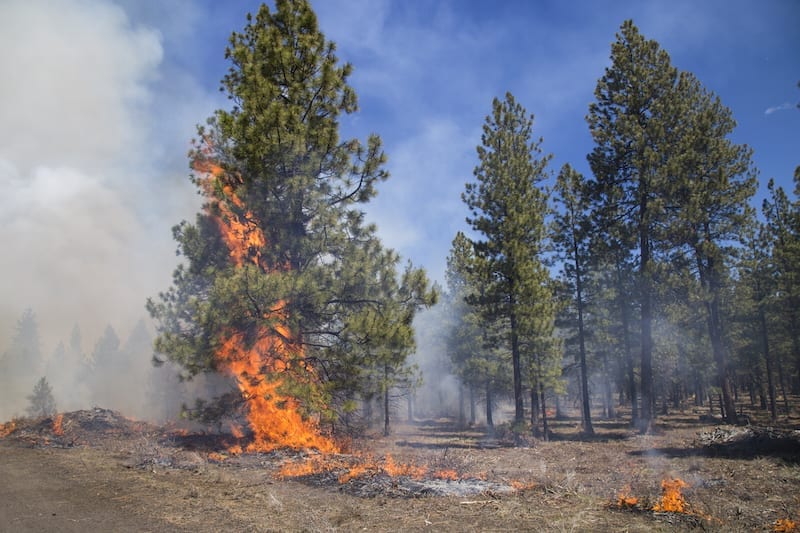
Caligiuri and other DCFP stakeholders started from the premise that fire was the ally, not the enemy, in any comprehensive forest restoration plan. In an area where dozens of homes and thousands upon thousands of acres have been lost to wildfire, that might seem counterintuitive. It’s also an about-face to the approach taken by commercial and public land managers who, for most of the 20th century, stomped out flames like they were ants at a family picnic. Ecologists admit that the Smoky the Bear approach might have made sense from a short-term perspective in a commodity driven resource economy—where trees translated to dollars, but only when trees were green. But putting out every wildfire comes at a cost, both in terms of resources and long-term forest health. Wildfires are incredibly expensive to fight. Last year, the Forest Service spent more than half of its total nationwide budget fighting wildfire, roughly $1.6 billion. As summers grow hotter and longer with each passing year, the task of battling every major wildfire appears Sisyphean at best.
In a dry forest ecosystem like that found on the east slope of the Cascades, “trying to stop fire is about as foolhardy as trying to stop a hurricane,” said Caligiuri.
On the other side, there is a growing body of research that suggests forests need fire like rivers need a good flood every so often. Healthy forests can not only withstand fire, but use them to regenerate. Fire is part of a cycle that sparks rebirth and helps maintain the ecological balance, creating wildlife habitat from burned wood while removing fuels that, when allowed to accumulate, can contribute to so-called catastrophic wildfires.
“There is a whole body of research around fire as part of the system,” said OSU’s Strong. “We are rethinking the relationship with fire and recognizing that we all moved into a fire-adapted landscape. It needs fire and we haven’t allowed that for over 100 years.”
The Deschutes Collaborative Forest Project started its work with the premise that a better understanding of the history and role of fire in the forest was essential to any large-scale restoration project. The challenge was how to reconstruct the history of a forest before humans were here to record it. What ensued was a forensic investigation of sorts, using clues left behind by the ghost of a forest’s past. As it turns out, the forest around Central Oregon had its own way of cataloging major events such as wildfires. The hidden history, including when fires burned and how far they spread, was locked in the trees that had survived the events. Most of those trees were felled long ago during the logging heyday, but the biological notes have endured, embedded in the tree rings and preserved in the stumps left behind after the logs were carted away. The Nature Conservancy worked with Oregon State University and the Forest Service to reconstruct this history using cross sections of these stumps. Just as climate researchers can piece together much of the earth’s climate history by studying core samples from polar ice fields, OSU researchers were able to reconstruct the behavior of fire in the forest, dating back more than 400 years. Scarring and other telltale signs found in samples taken from stumps west of Bend showed clearly that fire was a frequent visitor long before the first settlers arrived in Bend.
“The research very clearly paints a picture of how fire used to behave before a century of grazing and an intensive amount of logging,” said Caligiuri. “That opened everyone’s eyes to the dominant role that fire has played for a millennium in these ecosystems.”
On a recent tour of the forest area, Caligiuri walked gingerly on a surgically repaired ankle, a casualty of mountain biking accident in the same forest. He led me through an area that had been commercially thinned, just west of Bend and adjacent to the Cascade Lakes Highway. Just a few hundred feet from the Widgi Creek Golf Course and housing developments, the Forest Service, on the recommendation of the DCFP, employed a mix of tree removal and brush mowing to reduce overall vegetation density. The agency followed up with a controlled (or prescribed) burn—a low-intensity fire designed to mimic some of the natural fire activity that historically occurred in this type of ecosystem. The result is primarily open ponderosa pine, almost park-like. Bunches of pale green native grasses and shrubs have returned to the forest floor. What’s missing is the dense understory seen in so many other places that can transport otherwise innocuous flames from the forest floor to the canopy where it spreads like, well, wildfire. Eliminating these fuels is one of the easiest ways to fight wildfire proactively.
The DCFP is more than just a wildfire prevention strategy. The goal was to recreate the kind of forest, or at least the kind of forest conditions, that existed here prior to the arrival of settlers.
“It’s not that we are trying to go back to the past,” said Caligiuri. “What we are trying to say is we can learn from the past. So that becomes the white lines on either side of the road that keeps you more or less in the center of the lane. History becomes one line, and the future, climate change and the science around adaptation becomes another line.”
Voice of Skeptics
Not everyone agrees that more management of the forest is the recipe for healthier ecosystems. Paul Dewey has been leading the environmental charge on land use and forest health issues for more than two decades as the founder of Central Oregon LandWatch. An attorney by trade, Dewey helped beat back logging and development plans in the Metolius area during the late 1990s and 2000s. Since then he has focused on issues related to urban growth and the environment, challenging destination resort plans and unchecked suburban growth that has blurred the line between open spaces and private places in Central Oregon.
Dewey believes that the best way to fireproof communities like Bend is to limit building permits in areas where wildfire is a natural part of the ecology. In cases where development has already encroached, the answer isn’t thinning the forest, but preparing residents for the inevitable by making defensible spaces around homes and using fire-resistant building materials, such as metal roofs.
“The collaborative is talking about managing the forest, and the concern I have with that is it creates this impression that, if we only have the right management strategy, we can control wildfire. That’s such a dangerous attitude. With the right conditions, there is no way. These are climate-driven fires that no amount of human thinning is going to stop. What you have to do is then assume the bad one is going to hit and you have an urban design that can withstand that,” Dewey explained.
Dewey isn’t the only one with concerns about a management-intensive approach. George Wuerthner has been studying and writing about fire and western ecosystems for more than twenty years. An independent researcher, Wuerthner worked as a firefighter in his youth but spent the past decade-and-a-half as a researcher and writer at the Foundation for Deep Ecology, a pet project bankrolled by North Face founder Doug Tompkins. The organization was shuttered after Tompkins died in South America in 2015, yet Wuerthner carries on with his work, which has included keeping tabs on the Deschutes Collaborative Forest Project.
Wuerthner, who lives in Bend but travels around the country researching and speaking, said the scientific basis of the thinning and other management employed by the Forest Service at the behest of the DCFP is not as solid as they would have people believe. While there is an argument for creating defensible spaces in the immediate vicinity of homes and neighborhoods that adjoin the forest, the expansive ecosystem-wide approach is little more than good old-fashioned logging dressed up to look like environmental stewardship.
“They have gone hook, line, and sinker [into the notion] that the forests are denser than they used to be,” said Wuerthner. “These assumptions are driving fire policy as well as the forest restoration work and yet there are some who question how accurate those initial assumptions are.”
Forest in a Fish Bowl
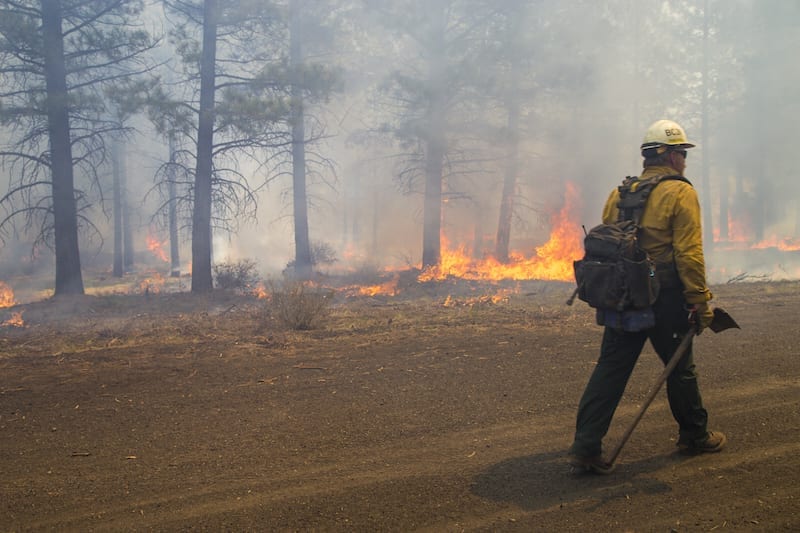
Caligiuri, Strong and other committee members are aware of the criticisms. It’s the reason that they say the DCFP took a scientific approach to its work.
“From the nature conservancy’s perspective, the question was, ‘Where is there needed restoration work to be done in the forest?’ and then understanding the scientific rationale for that work,” said Caligiuri.
“Ultimately, sustainability from a human perspective is dependent on coming up with a solution that finds that balance, but if we can start from a scientific foundation, we can have that conversation,” he added.
Strong said she understands that there are those who oppose any kind of management on lands, but that doesn’t solve the problems faced by our forests or our communities. Those who chose to engage in the collaborative forest did so with the understanding that it wasn’t a zero-sum proposition. Compromise was at the heart of the endeavor. And while no one got everything that they wanted, most who chose to participate got out what they put into the process.
“We focus a lot on the, ‘I can live with it,’ not ‘I’m getting everything I want.’ And that can be a tough point for some folks,” said Strong.
The fact that so many people are so passionate about our local forest underscores the importance of sharing the work that has gone into the collaborative process, said both Strong and Caligiuri. It’s one of the reasons that the collaborative has put a premium on a consensus and dedicated so much time and effort to telling that story to the community.
“It’s sort of a forest in a fish bowl. We have a lot of people that pay attention to it, and they pay attention to it for different reasons,” said Caligiuri. “I think that makes the work we are doing particularly important.




